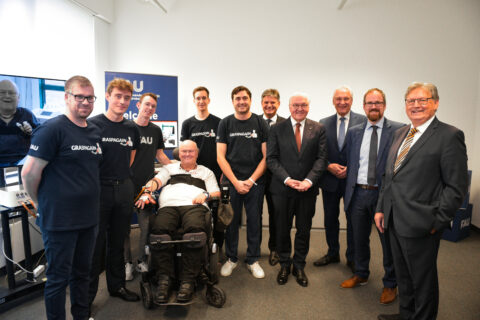Federal President Steinmeier visits GraspAgain!
In 2015, Mathias Follath, a patient of Dr. Matthias Ponfick, Chief Physician at the Rummelsberg Spinal Cord Center and a member of GraspAgain, suffered a spinal cord injury that fundamentally changed his life. Despite years of rehabilitation, he has not found a cure. This is not an isolated case, as 2,000 people in Germany experience similar injuries each year, and effective solutions are lacking for them, as well as for other injury and illness profiles.
We and the Chair for Manufacturing Automation and Process Systematics (FAPS) at Friedrich-Alexander University Erlangen-Nuremberg (FAU) have found an answer to the pressing question of how individuals with hand paralysis can regain their hand function through the GraspAgain project. GraspAgain represents an innovative neuroorthosis that measures neural signals and detects and transmits movement intentions to execute hand movements through mechatronic support. The concepts for GraspAgain stem from a discovery made by Professor Dr. Del Vecchio in 2020 in collaboration with the University of Pittsburgh and Imperial College London. Together, they found that paralyzed individuals still have measurable and interpretable muscle signals in their paralyzed limbs.
For the successful implementation of the project, we received the coveted Medical Valley Award in the spring of 2023, along with a grant of 500,000 euros. A key aspect of the project is the development of a neural interface that reliably and precisely provides four degrees of freedom. This allows for a wide range of precise gripping and finger movements with high precision for the paralyzed user. Additionally, a mechatronic orthosis is being developed, surpassing previous solutions in several important aspects, including safe use, high wearing comfort due to its low weight, effective power transmission, and the ability for proportional and independent finger control. New mechanisms address the issues of donning and doffing, as well as adaptation to different hand geometries depending on gender, age, and body constitution. When combined with the neural interface, which is directly connected to the brain through muscles, the neuroorthosis will, for the first time, provide fully intuitive control and feel natural to the user.
We were very excited to have had the opportunity to present GraspAgain to Federal President Steinmeier, who visited our laboratory on Tuesday, November 7th. He showed great interest in our innovation and we hope that we can use the funding we received to make GraspAgain available to many people who suffer from hand paralysis soon.
We would like to thank Anna Goldsworthy and Medical Valley EMN e. V. for the invitation to this important event and the opportunity to present GraspAgain to Federal President Steinmeier!
Image source: Medical Valley EMN e. V.

